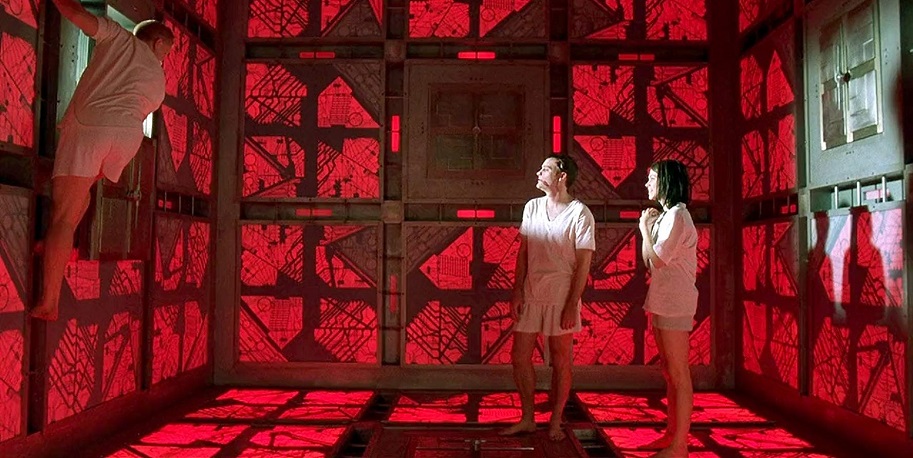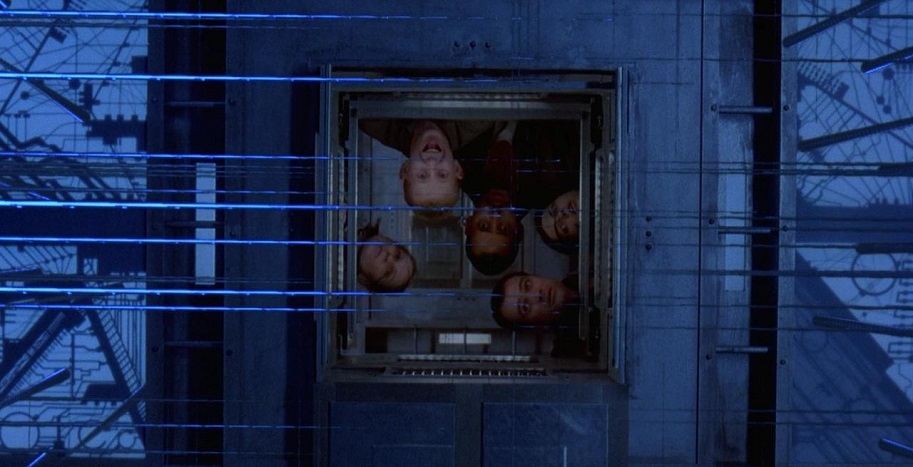Last Updated on August 2, 2021

We all have certain movies we love. Movies we respect without question because of either tradition, childhood love, or because they’ve always been classics. However, as time keeps ticking, do those classics still hold up? Do they remain must see? So…the point of this column is to determine how a film holds up for a modern horror audience, to see if it stands the Test of Time.

DIRECTED BY VINCENZO NATALI
STARRING DAVID HEWLETT, ANDREW MILLER, NICOLE DE BOER, MAURICE DEAN WINT
No f*cking way, 20 years already? Hot Damn! Well, how many of you vividly recall the first time you saw Vincenzo Natali’s CUBE? I know I do. A good friend of mine called me over saying he had a kickass new flick to show me, on VHS no less, that was sure to simultaneously f*ck my mind up and palpitate my heart in equal measure. Naturally, I was there in less than an hour. Of course, the movie did not disappoint, and when it was over, I sheepishly thanked my friend for making good on his promise to leave me in a state of hallucinatory apoplexy. Thanks a lot Matt, I’m still in recovery!
Point is, while CUBE was almost universally lauded for what it achieved on a miniscule budget of roughly $365,000 CAD and completed over a mere 20-day shoot, what about the actual substance of the movie itself? It’s one area of the movie I feel gets overlooked in favor of the inspired production design and elaborate set decorations. But at its heart, CUBE plumbs the age old social moral dilemma: can you cooperate with a person you do not know or get along with in order to ensure the survival of all involved? It’s an intrinsically dramatic query, and one of the things I always thought got short-shrift when people discussed CUBE when it was released in U.S. theaters back in September of 1998. Indeed, as the movie celebrates its 20th anniversary, revisiting THE CUBE with reinvigorated eyeballs reinforces the question of substance. Point blank: does CUBE have the staying power of all time genre classics? Let’s find out below when CUBE squares off with The Test of Time!

THE STORY: Written by Natali, Andre Bijelic and Graeme Manson (Orphan Black, Snowpiercer), the story is so simple it nears perfection. Six total strangers with various backgrounds suddenly awaken to find themselves trapped in a three-dimensional cube. No reasons why, no explanations given, no verbal directions of any kind are given. Perhaps a bit more telling, each character is not only named after a famous prison, each character shares the traits of the very prison their named after. We have Quinton (Maurice Dean Wint), who is cruel and ruthless; Leaven (Nicole de Boer), is a mathematic genius that hews to a sclerotic set of rules; Kazan (Andrew Miller) is a mentally impaired savant named after the prison in Russia for the mentally handicapped; Rennes (Wayne Robson), a French prison that trailblazed policing practices; Holloway (Nicky Guadagni) is named after a women’s prison in England (The Kinks have a great song called Holloway Jail); Alderson (Julian Richings) is a jail known for solitary confinement; and Worth (David Hewlett) is the architect with the greatest value among the six.
Anyhow, as the six strangers are forced to work with one another to escape the CUBE unscathed, they soon realize there are countless rooms with deadly traps waiting to take their lives if a wrong step is taken. Of course, aside from the terror of death, the sextet also contends with crippling claustrophobia and personal infighting as they move from one room to the next, each color-coded in an array of white, blue, red, green and orange hues. Interestingly, Natali wanted to shoot the film in chronological order, but what made more logistical sense was to use only one cube for the entire set, and shoot in order of each colored room, which were achieved by simple gel-filters placed over the camera lens. So that means all the red-room scenes were shot in sequence, then the blue-room scenes, then the white, and so on. Pretty f*cking cool! When Leaven unlocks the math behind the cube’s rotating blocks, the crew is somehow able to navigate their way back to the starting position and mount a daring escape. But if you think CUBE has a happy ending, it’s time to see the flick again!

WHAT HOLDS-UP: Let’s be honest, a movie this good made in 20 days with $365,000 CAD is almost beyond reproach. Seriously, we’ve seen movies with ten times the budget and one tenth the quality of CUBE, and this shan’t be understated. CUBE is a hell of feat given its hamstringing resources. But more than the mere achievement of something so good with such paltry raw materials to work with, CUBE boasts three really strong elements that have not corroded much over the past 20 years. In fact, in some ways, they’ve appreciated. CUBE’s plotted premise (and concomitant production design), expansive influence, and grisly violence hold serve as the movies three foundational bedrocks!
We detailed it above, but the pure premise and coolly conceptualized conceit of CUBE is one of the undeniable pillars will forever lean on. The idea of six total strangers navigating through a morass of murderous mazes – each with their own specialty or are of expertise – who must work together to ensure survival is simply too persuasive to wear out over time. The geometry of the cube itself is also uniquely inspired and contributes to the movies staying power; whether it’s the way each room is constructed, or how the cube rotates to create permutations, or that it is calculated to have over 17,000 rooms is all very intriguing, and reminds me of another monosyllabic mathematical based sci-fi thrillers from 1998, Darren Aronofsky’s PI. Of course, the idea is one thing, but the production design by Jasna Stefanovic (MEN WITH GUNS, THE VIRGIN SUICIDES) really immerses you in a specific environment to evoke a trapped feeling from start to finish.

To this end, one might argue that the wide-reaching influence of CUBE is actually more substantial than the movie itself. Never mind the mindless CUBE sequels that came about, let’s talk about how much the entire SAW franchise owes to CUBE’s single-setting, high-concept premise. Strangers awake to face grisly deathtraps and are forced to cooperate in order to survive? The only difference is the puppeteering presence of Jigsaw, who gives direct orders. Or hell, I even think THE MATRIX owes at least a modicum of inspiration to CUBE, not thematically, but in terms of the dystopic, steam-punk production design and mathematically inclined set-pieces. The scenes in CUBE where Holloway scales down the outskirts of the complex, or when we see the elevator descend later in the film, it starkly reminds of the area Neo navigates when first realizing he’s in the matrix. CUBE itself may not have enjoyed the massive success of the SAW and MATRIX franchises, but damn if they didn’t lay the groundwork for those massive properties to capitalize on what Vincenzo conceptualized.
Not for nothing, but if seen the other way around, I’m struck by Vincenzo’s inspiration from Dustin Hoffman. Not only is Kazan an idiot savant much like Hoffman’s Rain Man, he even saves the day in the end by using his mathematical acumen (just like Rain Man with the toothpicks, in Vegas, etc.). What strikes me doubly is Leven’s pair of round-rimmed glasses that has one lens shattered. This instantly calls to mind the poster for Peckinpah’s STRAW DOGS, which of course stars Dusty Hoffman as what? Yup, a mathematician! I can’t claim to know the significance of the Hoffman connection, but I can’t deny its presence there either. Just another weird ass phenomenon of CUBE!

Really though, let’s talk about death baby. There are four fatalities in all of CUBE, and three of them hold up extremely well by today’s standards. It starts with Alderson’s vicious vivisection. This poor bastard waltzes headlong into an invisible lattice of razor-sharp wiring and is gorily, gorgeously, gloriously sliced into equally sized portions of butchered human flesh, bone and viscera. It’s a showstopper of first fatality, and lets you know right up front how gnarly the stakes are in the movie for anyone who makes a miscalculated move. I remember being floored when I first saw this death scene, and I happily report it still retains its potency today.
Same goes for the wonderfully wicked second death-stroke. This time Rennes, The Wren who escaped seven prisons previously, is victimized when walking into a room he deems trap-free. Dead wrong, Renne’s face is spritzed with highly caustic acid, which eats his facial skin until his head is nothing more than a gruesome cavern of puss-bubbling blood and bile. The practical FX work here is outstanding, and really retains its shocking brutality. The final fatality, in which Quinton survives his own death in order to suddenly show up and impale Worth with a spiked metal handle, is actually more alarming from a dramatic standpoint than a visual one. Just as we’re led to believe a happy ending is on the horizon, hell no, Worth is abruptly jabbed through the heart and left to bleed out to death. Shite’s jarring!

WHAT BLOWS NOW: It probably blew then too, but man, the shoddy performances of a few of the CUBE victims is almost unbearable to take seriously today. I’m talking almost solely about Maurice Dean Wint as Quinton. Good god, this guy gives a horribly histrionic turn that’s akin to that in a bad ‘70s exploitation film. The mugging, the brow-raising, the ludicrous line-readings, I mean it, Quinton damn near single handedly ruins the experience of CUBE when he’s onscreen. Thankfully his over the top turn is pared down by Andrew Miller and David Hewlitt, two actors who worked together on the stage before making CUBE. Those two along with Guadagni and de Boer are at the emotional core of CUBE, but this brings us to another thing that kind of suffers when watching the flick in 2018. Because we know very little about each character, it’s hard to sympathize with them at great lengths. Then again, the appeal of CUBE isn’t necessarily seeing likeable characters survive, the appeal is how the CUBE is going to ferociously fell unsympathetic strangers.
THE VERDICT: All things considered, it’s not just that CUBE withstands the Test of Time on its own merit, which it most certainly does, but that it has endured the last 20 years despite its shoestring budget and rapid shooting schedule. A movie this sturdy never comes at such an inexpensive cost, which doubles its impressiveness. But even more than that, and even beyond the movies standalone durability, the sweeping influence CUBE has had on sci-fi thrillers in the past two decades might be its most important overall impact. One can’t think of the SAW movies without calling CUBE to mind, and to a lesser degree, the same goes for THE MATRIX, THE COLLECTOR, and other labyrinthine techno-deathtrap chillers that have come along (CHATROOM comes to mind). With a piercing premise, severe stints of violence and a lasting lineage left behind, on the whole, CUBE’s as patient as the Pyramids.


















Follow the JOBLO MOVIE NETWORK
Follow us on YOUTUBE
Follow ARROW IN THE HEAD
Follow AITH on YOUTUBE